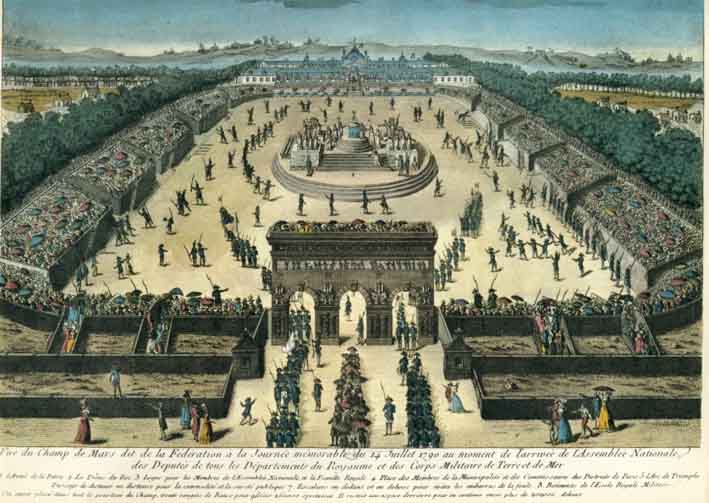|
|||
|
Philatelia.Net / French revolution / Plots / The directory «Plots»The Fête de la FederationThe Fête de la Fédération of the 14 July 1790 was a huge feast and official event to celebrate the establishment of the short-lived constitutional monarchy in France and what people of the time considered to be the happy conclusion of the French Revolution the outcome hoped for by the monarchiens. The Fête de la Fédération in Paris was the most prominent event of a series of spontaneous celebrations all over France: from August 1789, Fédérations appeared in towns and countryside; on 5 June 1790, with lots of individual feasts to celebrate the new state of France, a constitutional monarchy. The National Assembly approved the suggestion by the Commune de Paris to organise a "general Federation". Organised late, it was largely an improvisation. The idea was not to contest the legitimacy of the king Louis XVI, but to show the general will for stable institutions and a national reconciliation and unity. In the words of Jean Sylvain Bailly, astronomer and mayor of Paris: "We suggest that this meeting (...) be sworn on the next 14 July, which we shall all see as the time of liberty: this day shall be spent swearing to uphold and defend it". Charon, President of the Commune of Paris, stated: "French, we are free! French, we are brothers!". The event took place on the Champ de Mars, which was at the time far outside Paris. The place had been transformed on a voluntary basis by the population of Paris itself, in what was recalled as the Journée des brouettes ("Wheelbarrow Day"). Two 400 000 spectator earth steps were built on each side of the field (they remained there until the Second Empire). The Seine was crossed by a bridge of boats leading to an altar where oaths were to be sworn. The new military school was used to harbour members of the National Assembly and their families. At one end of the field, a huge tent was the king's step, and at the other end, a Triumphal Arch was built. At the centre of the field was an altar for the mass. The feast began as early as four in the morning, under a strong rain which would last the whole day (the Journal de Paris had predicted "frequent downpours"). 14 000 Federated (Fédérés) came from the province, every single National Guard unit having sent two men out of every hundred. They were ranged according to their département under 83 banners. They were brought to the place were the Bastille once stood, and went through Saint-Antoine, Saint-Denis and Saint-Honoré streets before crossing the temporary bridge and arriving at the Champ de Mars. Deputies from other nations, "Swedes, Spaniards, Polacks, Turks, Chaldeans, Greeks, and dwellers in Mesopotamia," representatives of the human race, "with three hundred drummers, twelve hundred wind-musicians, and artillery planted on height after height to boom the tidings all over France, the highest recorded triumph of the Thespian art." A mass was celebrated by Charles Maurice de Talleyrand, bishop of Autun under the Ancien Régime. The very popular General marquis de La Fayette, as both captain of the National Guard of Paris and confident of the king, took his oath to the Constitution. It is noticeable that at this time, the French Constitution of 1791 was not yet written; it would only take effect in September 1791. La Fayette was followed by the President of the National Assembly. Eventually, Louis XVI took his oath. The , used for the first time instead of "King of France (and Navarre)", was an innovation intended to inaugurate a "popular monarchy" which linked the monarch's title to the people, not to the territory of France. With the permission of the National Assembly, a delegation of the United States of America, led by John Paul Jones, founder of the US Navy, joined the feast. The delegation arrived at the Champ de Mars with its flag, the first instance ever of a US flag flown outside of the USA, and was cheered by the people. After the end of the official celebration, the day ended in a huge popular feast. It was also a symbol of the reunification of the Three Estates, after the heated Estates-General of 1789, with the Bishop (First Estate) and the King (Second Estate) blessing the people (Third Estate). In the gardens of the Château de La Muette, a meal was offered to 22,000, before balls took place. People drank, danced, sang and toasted. The organisation went up to deciding of the price of the filles du Palais-Royal (prostitutes). The feast ended on the 18 July. Bangladesh, 1989, Celebration of the Federation on Champ de Mars Bequia, 1989, Planting the Liberty tree Bequia, 1989, Karmaniola Ecuador, 1989, French Revolution France, 1991, Tree of Liberty Gabon, 1989, Phrygian Cap and Sans-culotte Ghana, 1989, Tree of Liberty Guinea Bissau, 1989, Dancing round Tree of Liberty Guinea Bissau, 1989, Arms of the Republic of France Israel, 1989, Tree of Freedom Jersey, 1989, Marie de Bouillon and Revolutionaries, 1790 Maldives, 1990, Oath of Lafayette 14 July 1790 Nicaragua, 1989, Tree of Liberty Nicaragua, 1989, La Fayette taking Oath Niger, 1989, Planting a Tree of Liberty Niger, 1991, Honore de Mirabeau Peru, 1990, La Fayette at the Festival of Republic Togo, 1989, Talleyrand and Lafayette Togo, 1989, Barras, Robespiere Wallis & Futuna, 1992, Victorious Marianne France, 1991.06.01, Wallis & Futuna, 1992.08.17, Advertising: |
|||
© 2003-2025 Dmitry Karasyuk. Idea, preparation, drawing up
|

